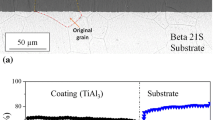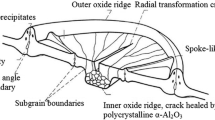Abstract
Studies on microstructures and compositions of model diffusion aluminide coatings coupled with existing information on diffusion in nickel-aluminum intermetallic compounds indicate that only two basic types of these coatings can be formed on nickel-base superalloys. The first type is formed by inward diffusion of aluminum from coating media of sufficiently high aluminum activity to cause formation of the δ (Ni2Al3) phase. Subsequent stabilizing heat treatments required for practical use of this type of coating cause some outward diffusion of nickel to form a three-zone β(NiAl) coating. The second type is formed by outward diffusion of nickel from the substrate alloy to react with aluminum of suitable activity to stabilize that β(NiAl) phase of composition through which only nickel motion can occur. This process produces a two-zone β(NiAl) coating. It follows that the structural type of coating to be expected from any given coating process can, in principle, be predicted from knowledge of the aluminum activity present during formation of the coating. The initial stages of diffusional degradation of these coatings involve continued outward diffusion of nickel from the substrate through the β(NiAl) coating with the resultant dilution of aluminum content of the coating; little inward diffusion of aluminum occurs.
Similar content being viewed by others
References
F. S. Pettit,Trans. TMS-AIME 239, 1296 (1967).
G. W. Goward, D. H. Boone, and C. S. Giggins,ASM Trans. Quart. 60, 228 (1967).
T. K. Redden,Trans. TMS-AIME,242, 1695 (1968).
M. J. Fleetwood,J. Inst. Metals 98, 1 (1970).
M. M. P. Janssen and G. D. Rieck,Trans. TMS-AIME 239, 1372 (1967).
A. Taylor and R. W. Floyd,J. Inst. Metals 81, 451 (1953).
I. I. Kornilov and R. S. Mints;Z. Neorg. Khim. 3, 699 (1958).
A. J. Bradley and A. Taylor,Proc. Roy. Soc. (London) A159, 56 (1937).
T. von Heumann and S. Dittrich,Z. Metallk. 50, 617 (1959).
J. Margalit, G. Kimmel, and S. Niedzwiedz,J. Inst. Metals 98, 126 (1970).
A. Steiner and K. L. Komarek,Trans. TMS-AIME 230, 786 (1964).
M. Ettenberg, K. L. Komarek, and E. Miller,Trans. TMS-AIME 242, 1801 (1968).
W. Johnson, K. L. Komarek, and E. Miller,Trans. TMS-AIME 242, 1685 (1968).
Author information
Authors and Affiliations
Rights and permissions
About this article
Cite this article
Goward, G.W., Boone, D.H. Mechanisms of formation of diffusion aluminide coatings on nickel-base superalloys. Oxid Met 3, 475–495 (1971). https://doi.org/10.1007/BF00604047
Received:
Issue Date:
DOI: https://doi.org/10.1007/BF00604047




